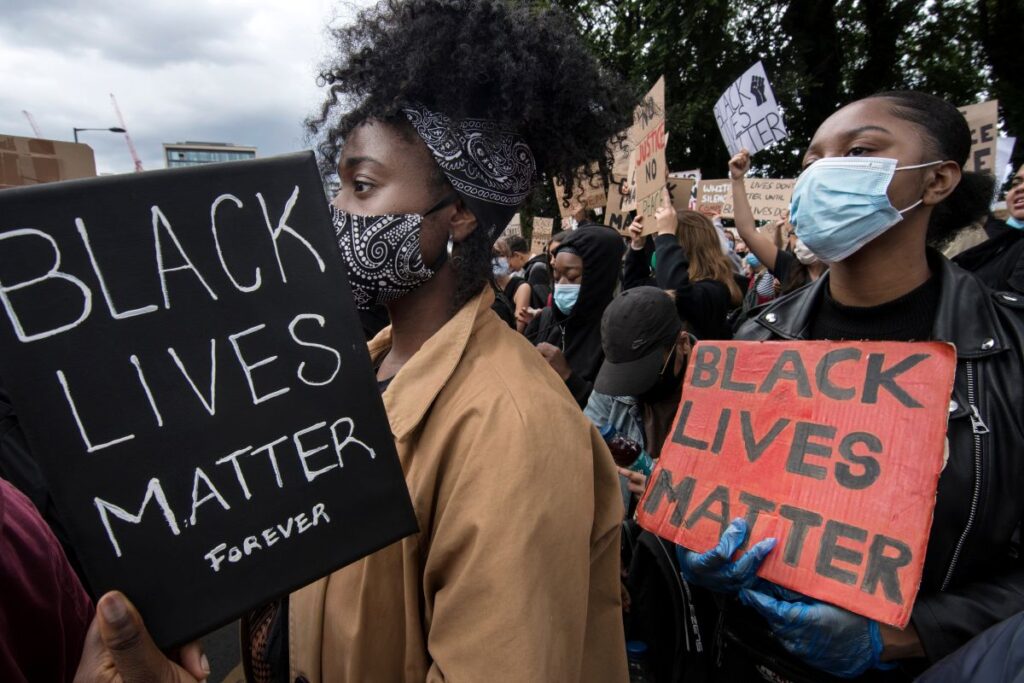Change and Continuity in Black Freedom Struggles
This post is part of our online roundtable on Françoise N. Hamlin and Charles W. McKinney Jr.’s From Rights to Lives.

Black lives matter. Understood in the axiomatic sense, this phrase represents a basic contention that few people would openly contest. However, #BlackLivesMatter and its concomitant demand—as articulated by Patrisse Cullors, Alicia Garza, and Ayọ (formely Opal) Tometi—that “Our lives matter, Stop killing us” stands as one of the most polarizing motifs of the recent past. Sparked by several high-profile police murders of African Americans, the collective rage and potent messaging triggered a mass movement that brought to light the problem of police violence and murders that terrorized Black communities. Not content with just bringing individual bad actors to justice, protesters forwarded an expansive critique that revealed the extent to which police violence was not an isolated problem but emblematic of the deeply interconnected and complex nature of white supremacy and Black subordination in America and, by extension, the West.
As with all phenomena, making sense of the movement that Cullors, Garza, and Tometi inspired would be challenging enough if, as professional historians prefer, the “dust” had settled on this history and the archivists had time to collect, organize, and curate the historical ephemera. Responding to the urgency of the contemporary moment, however, the contributors to From Rights to Lives: The Evolution of the Black Freedom Struggle, edited by Africana Studies scholars and historians Françoise N. Hamlin and Charles W. McKinney Jr., have confronted the challenge of exploring this complicated episode with, in the academic parlance, a “history of the present.”
The essays, as kinds of first drafts of history, stand at some intersection between history, sociology, and cultural criticism.
The authors lean into the unsettledness of the subject matter and take advantage of the opportunities to explore both facts and broad truths in this next chapter of social movement history and the seemingly never-ending struggles to realize an expansive definition of citizenship and imbue society with a greater capacity to regard all residents with humanity and empathy.
In a volume that foregrounds the problems of tension and comity as well as change and continuity in Black freedom struggles, Charity Clay tends to the politics of propriety when youthful protestors embraced disruptive tactics in their social media campaigns that aroused criticism from the likes of Oprah Winfrey. On a slightly different front, Peter Pihos explores the tensions between otherwise reform-minded African American police officers—who challenged racism among their fellow officers under the banner of Black Power but were nonetheless steeped in the patriarchal and masculinist ethos of their guild—and activists who were guided by queer Black feminist ideals. Gender, as a mode of analysis, is thus revealed as a fracturing component across various Black professional and social positionalities.
And then there are the myriad synergies. In their survey of the spiritual foundations of #BlackLivesMatter, Christophe D. Ringer sees echoes of Vincent Harding’s brand of liberation theology and the love ethos in Martin Luther King’s philosophy of nonviolence, albeit in the body and spirit of a women-centric leadership structure. Althea Legal-Miller traces the arc of history from President of the National Council of Negro Women Dorothy Height to Grace Franklin and Candace Liger, both Oklahoma City-based artists, who fought against the scourge of police sexual violence against Black women. Scott N. Brooks and Aram Goudsouzian recall the late-1960s campaign titled “Revolt of the Black Athlete” to then highlight the broad coalition of athletes who leveraged their elevated status in the contemporary media climate to protest high-profile deaths of African Americans. Kishauna Soljour sets #BlackLivesMatter in the context of the Black Atlantic. Racially repressive policing and Black protest, we are reminded, are constitutive features of both the United States and France.
Finally, readers can assess the extent to which art operates at cross purposes. Mickell Carter identifies how music audiences repurpose popular songs as movement anthems to aid mass mobilization. David V. Mason charts the intersection of documentary photography and whiteness in ways that reinforce the prevailing racial order.
Like all great volumes that capture the complexity of our collective past (no matter how recent and still unfolding), From Rights to Lives and its particular focus on the agency of subjects central to the struggle compelled me to reflect upon several related historical and ethical problems. The contributors’ critical engagements with matters of strategy and tactics, intra-movement tensions, leadership structure, and technologies of change are powerful reminders of the difficulties that face people committed to making the world a better place. Herein lies important lessons for movement scholars, theoreticians, and practitioners alike.
I was also reminded of a great irony in the framing and execution of #BlackLivesMatter. For all the great ambitions, complexities, contingencies, and contradictions of the movement, there is a basic beauty and power about the motto that speaks to an essential component of Black peoples’ strivings, no matter the ideological variance. On some foundational level, Black folks have merely asked to be regarded as men, women, and children—as citizens—deserving of the ordinary rights and privileges that are regularly afforded their white contemporaries. They yearn for equality and equity and the opportunity to realize their individual potentials, raise their families, and serve their communities like their neighbors across the color line. How better to articulate that collective commitment except to insist that, “Our lives matter, Stop killing us.” That this simple request—to live—was not something by which an ideologically diverse and bipartisan coalition of political, economic, and cultural authorities could abide tells us something profound about the DNA of our society. This terrible problem is a prompt for more quality interrogations of the histories of our open-ended present, and it demands continued diligence and scholarly ingenuity to comprehend and fight.
Copyright © AAIHS. May not be reprinted without permission.